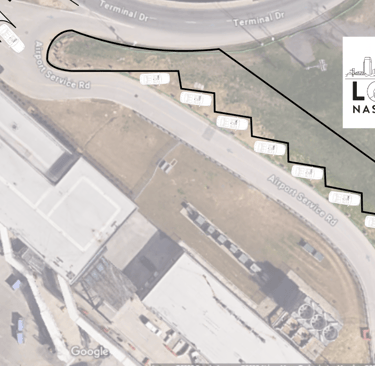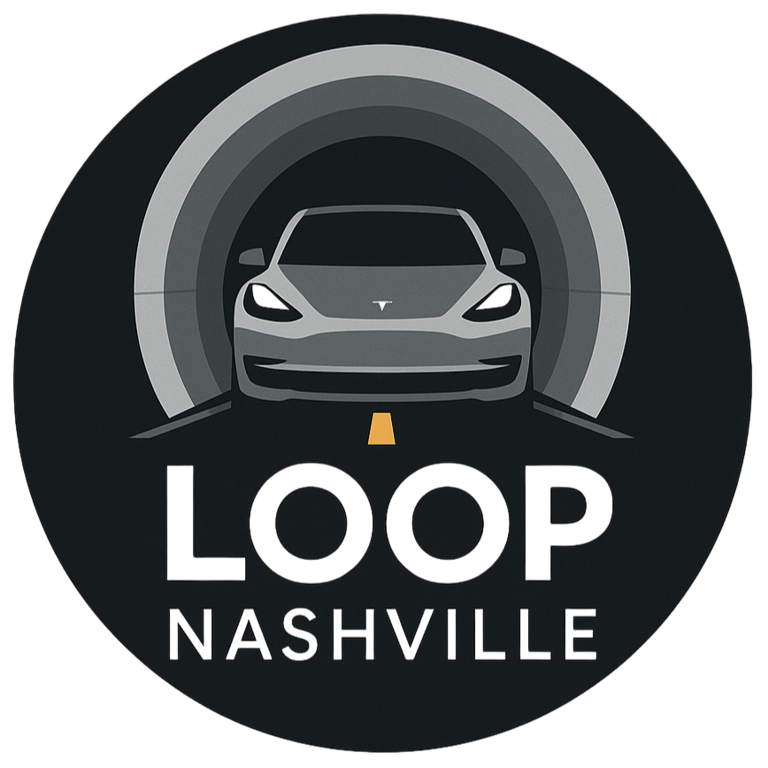Exclusive: First Look at Potential BNA LOOP Station
The Nashville Business Journal reports new details on The Boring Company’s proposed Music City Loop connection at Nashville International Airport. The tunnels would surface near Concourse D, linking to a station with seven loading bays connected by a covered walkway to the terminal. Our post also includes a hypothetical artist rendering of an airport LOOP station — exclusive to LOOP Nashville. [Read more ➝]
By the LOOP Nashville Editorial Staff
8/27/20252 min read


By the LOOP Nashville Editorial Staff
The Nashville Business Journal has uncovered new details about how Elon Musk’s Boring Company envisions connecting its proposed “Music City Loop” tunnels to Nashville International Airport (BNA).
Reporting by NBJ Senior Reporter Adam Sichko reveals that the twin tunnels would emerge on airport property in a small area of diagonal white striping near Concourse D—an area every driver leaving the airport passes along Terminal Drive.
How the Airport Connection Would Work
According to a draft letter of intent between the Metro Nashville Airport Authority (MNAA) and The Boring Company, the two tunnel portals would sit side-by-side in a 4,200-square-foot zone at that striped area.
Tunnel vehicles—Tesla cars operated by Boring Co. drivers—would travel about 425 feet on an existing service road before reaching a 20,000-square-foot covered pick-up and drop-off area inside the terminal. That space is currently used by taxis and limousines, which would be relocated if the tunnels are built.
Passengers heading downtown would board in that same space and then head into the tunnels, bypassing traffic at speeds of up to 70 mph.
Negotiations and Challenges
Airport CEO Doug Kreulen confirmed that discussions with The Boring Company have been ongoing for months, but no agreement has been finalized. “I’m all-in on the idea of a tunnel between Nashville and BNA. Can we do it? It’s possible,” Kreulen told the Business Journal. Still, he cautioned that the plan remains “theoretical” until a signed agreement and construction drawings are in place.
The airport is in the midst of a $3 billion expansion, including new garages, wider roadways, and a rental car facility with space for nearly 5,000 vehicles. Kreulen noted that the longer talks with The Boring Company drag on, the harder it will be to coordinate tunnel construction with the airport’s own infrastructure upgrades.
Importantly, the draft letter of intent states that The Boring Company would be responsible for covering any additional costs needed to modify airport infrastructure to accommodate the tunnels.
The Bigger Picture
The Music City Loop envisions 9.5 miles of parallel, one-way tunnels between downtown Nashville and the airport, entirely under state and airport-owned land. The downtown end would sit at a state-owned lot near the Capitol at 637 Rosa L. Parks Blvd., which Boring Co. is leasing for free.
At the airport, though, the deal is more complex—requiring negotiations over land use, ride fees, and integration with ongoing construction projects. The MNAA has also proposed a $5 per-ride surcharge, mirroring what Uber and Lyft currently pay.
For Boring Co., the airport end of the loop is critical: BNA handled a record 24.8 million passengers last year, and that volume is a major factor in the ridership projections that could sustain the tunnel system.
What a LOOP Station Could Look Like
Based on the design of stations already constructed for the Vegas LOOP, a Music City Loop station at BNA would likely be a simple, efficient structure. A covered concrete curb would connect directly to the terminal via a covered walkway, ensuring passengers can move seamlessly between the terminal and the LOOP system.
In an early artist rendering, exclusive to LOOP Nashville, the tunnel is shown emerging from the ground near the striped pavement area to the northwest of the terminal. Vehicles would then use the existing airport service road to access the LOOP station. The concept includes seven loading bays, allowing LOOP vehicles to pull in, load passengers, and depart without needing to reverse.
Once loaded, vehicles would re-enter the city-bound tunnel to the southeast, traveling under Donelson Pike before linking up with Murfreesboro Pike on the 9.5-mile route back to downtown Nashville.
Source: Reporting by Adam Sichko, Senior Reporter, Nashville Business Journal (Aug. 26, 2025).
Disclaimer
LOOP Nashville aggregates publicly available news, commentary, and editorial content related to the Music City LOOP project. All source material is fully credited and attributed to its original publishers. All commentary and editorial opinions are solely those of the LOOP Nashville Editorial Staff. We are an independent site and are not affiliated with The Boring Company or the Music City LOOP project.
CONTACT
Follow
scoop@loopnashville.com
© 2025. All rights reserved.
